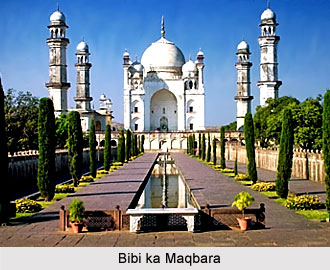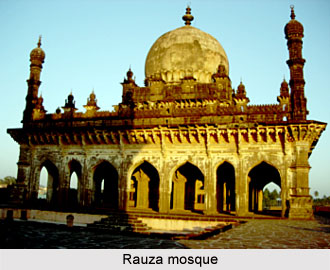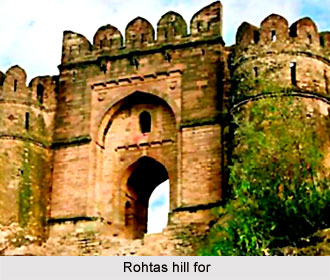 The region of Bihar in eastern Indian purview was a crucial one which has arrested attention since the times of Gautama Buddha in pre-Christian era. Regarded as an abode of ancient architectural as well as a religious epitome, Bihar could never be ignored by the Mughals. They needed to keep the place as a stronghold in order to establish their supremacy in far-off regions from Delhi. Indeed, as with their predecessors, the later Mughals had also assayed to emphasise their superiority in Bihar architecturally. In a strange and uncanny matter of ancestral and progeny competition, architecture of Bihar during the later Mughals is an issue of considerable wonder and interest for researchers and historians and readers of Indian history in contemporary times.
The region of Bihar in eastern Indian purview was a crucial one which has arrested attention since the times of Gautama Buddha in pre-Christian era. Regarded as an abode of ancient architectural as well as a religious epitome, Bihar could never be ignored by the Mughals. They needed to keep the place as a stronghold in order to establish their supremacy in far-off regions from Delhi. Indeed, as with their predecessors, the later Mughals had also assayed to emphasise their superiority in Bihar architecturally. In a strange and uncanny matter of ancestral and progeny competition, architecture of Bihar during the later Mughals is an issue of considerable wonder and interest for researchers and historians and readers of Indian history in contemporary times.
The finest later Mughal mausolea in Bihar are modelled on the tombs of Iftikhar Khan in Chunar and Shah Daulat in Maner, each built during Jahangir`s reign. Amongst these are tombs erected for Shamsher Khan and Ibrahim Husain Khan, both following the plan and elevation of the tombs from Jahangir`s time, but embellished with motifs characteristic of eighteenth-century ornamentation. That is, each tomb possesses a domed central chamber surrounded by an open veranda. Ibrahim Husain Khan`s tomb in Bhagalpur bears no date, but its interior and exterior walls, ornately articulated with stucco ornament, reflect the increased surface elaboration seen in much eighteenth-century architecture across north India. Also demonstrating these new motifs is Shamsher Khan`s tomb, yet another imperative architectural piece of work in Bihar during the later Mughals. Amongst these new features was present the dome`s high drum with screens that is surmounted by bangala roofs. Shamsher Khan had served for some time as governor of Patna (then acknowledged as Azimabad) during the reign of Shah Alam Bahadur Shah. He, like his uncle, Daud Khan, had founded a town in his own name, Shamshernagar, not far from Daudnagar. There, Shamsher Khan had in fact built his own tomb, a serai (a rest house for travellers and caravans, built during Mughal era) and well before his death in 1712. Only the tomb remains though in present times, which can still be noted as one of the striving excellences of architecture of Bihar during the later Mughals.
 In contrast to the fine late Mughal mausolea of Bihar is the austere Jami mosque of Silao in Nalanda District. This single-aisled three-bayed mosque, constructed in 1741-42 by a father and son, Sayyid Muhammad and Sayyid Ghulam Najaf, is enclosed by high walls, not common in eastern India during this time, yet one more feature of amalgamated architecture under later Mughals in Bihar. Each of the exterior walls bear inscriptions, again unusual for later Mughal architectural patterns in Bihar in eastern India. Like the exterior, the Jami mosque`s interior is sparsely ornamented. Cusped mihrabs (a niche in the wall of a mosque that indicates the qibla, i.e., the direction of the Kaaba in Mecca and hence the direction that Muslims should face while praying; the wall in which a mihrab appears is thus the "qibla wall") and a more complex form of pendentives than seen before in Bihar are the sole decorative devices in the Jami mosque of Silao. The contrast with such contemporary monuments as Ibrahim Husain Khan`s tomb in Bhagalpur indicates that in eighteenth-century Bihar no single ornamental style prevailed even under Mughal rule, probably because there was no single strong patron or model.
In contrast to the fine late Mughal mausolea of Bihar is the austere Jami mosque of Silao in Nalanda District. This single-aisled three-bayed mosque, constructed in 1741-42 by a father and son, Sayyid Muhammad and Sayyid Ghulam Najaf, is enclosed by high walls, not common in eastern India during this time, yet one more feature of amalgamated architecture under later Mughals in Bihar. Each of the exterior walls bear inscriptions, again unusual for later Mughal architectural patterns in Bihar in eastern India. Like the exterior, the Jami mosque`s interior is sparsely ornamented. Cusped mihrabs (a niche in the wall of a mosque that indicates the qibla, i.e., the direction of the Kaaba in Mecca and hence the direction that Muslims should face while praying; the wall in which a mihrab appears is thus the "qibla wall") and a more complex form of pendentives than seen before in Bihar are the sole decorative devices in the Jami mosque of Silao. The contrast with such contemporary monuments as Ibrahim Husain Khan`s tomb in Bhagalpur indicates that in eighteenth-century Bihar no single ornamental style prevailed even under Mughal rule, probably because there was no single strong patron or model.
 Patna had remained Bihar`s leading commercial centre, a thing which has not changed in contemporary dates. The city was even enlarged under Prince Azim al-Shan, governor of Bihar during the early eighteenth century. Azim al-Shan had renamed Patna city as `Azimabad`, proclaiming his desire to give birth to a second Delhi. His efforts had failed though, as did his bid for the throne, but Patna still continued to benefit from the patronage of political figures and wealthy merchants. Amongst the structures they had provided, the most elegant is the mosque of Mir Ashraf, constructed by a Patna businessman in 1773-74. Its articulated facade with petal-like kungura, cartouches and arched niches is characteristic of those seen throughout India in the 18th century, much near to later Mughal rule from the British invasion. As such, tempted to be reiterated over and over, architecture of Bihar during later Mughals was an emulation and imitation of the earlier Mughals in every respect, though not even near to such masterworks. The interior of Mir Ashraf`s mosque, too, emotes ornateness from each angle, for cartouches and arch motifs embellish the walls and dome. The floor of the prayer chamber is composed of multicoloured tiles of the sort used on pre-Mughal Bengali structures. This unique flooring is in keeping with the mosque`s articulated surfaces, related to that of contemporary architecture in Murshidabad, for example, Munni Begum`s Chowk mosque erected in 1767.
Patna had remained Bihar`s leading commercial centre, a thing which has not changed in contemporary dates. The city was even enlarged under Prince Azim al-Shan, governor of Bihar during the early eighteenth century. Azim al-Shan had renamed Patna city as `Azimabad`, proclaiming his desire to give birth to a second Delhi. His efforts had failed though, as did his bid for the throne, but Patna still continued to benefit from the patronage of political figures and wealthy merchants. Amongst the structures they had provided, the most elegant is the mosque of Mir Ashraf, constructed by a Patna businessman in 1773-74. Its articulated facade with petal-like kungura, cartouches and arched niches is characteristic of those seen throughout India in the 18th century, much near to later Mughal rule from the British invasion. As such, tempted to be reiterated over and over, architecture of Bihar during later Mughals was an emulation and imitation of the earlier Mughals in every respect, though not even near to such masterworks. The interior of Mir Ashraf`s mosque, too, emotes ornateness from each angle, for cartouches and arch motifs embellish the walls and dome. The floor of the prayer chamber is composed of multicoloured tiles of the sort used on pre-Mughal Bengali structures. This unique flooring is in keeping with the mosque`s articulated surfaces, related to that of contemporary architecture in Murshidabad, for example, Munni Begum`s Chowk mosque erected in 1767.
Whether ornate or austere, religious architecture in Bihar under the later Mughals, as in Awadh and Murshidabad, reveals virtually no European influence. The Bawli Hall mosque on the estate of a 19th century residence, for instance, displays the features of Mughal architecture. The mosque`s central facade owns a rather lobed entrance arch and a parapet of domed kungura, recalling features of the 1841-42 mosque of Hamid Ali Khan, Delhi`s last significant Mughal mosque. No European forms had been utilised on the Bawli Hall mosque; rather, its design reflects contemporary work at the Mughal capital more than anything seen in the closer centres of Awadh and Murshidabad. By contrast, the residence reveals considerable European influence following patterns set forth in Lucknow and Murshidabad and the nawab architectural framework post the architectural waning wonders of Bihar during later Mughal rule. Bawli Hall, the nineteenth-century residence of Nawab Luft Ali Khan, once had served as an extensive mansion little different from contemporary British buildings in India. Abandoned in present times, the Hall demonstrates the extent that British architecture served as the model for houses of important figures in later Mughal successor states.






































